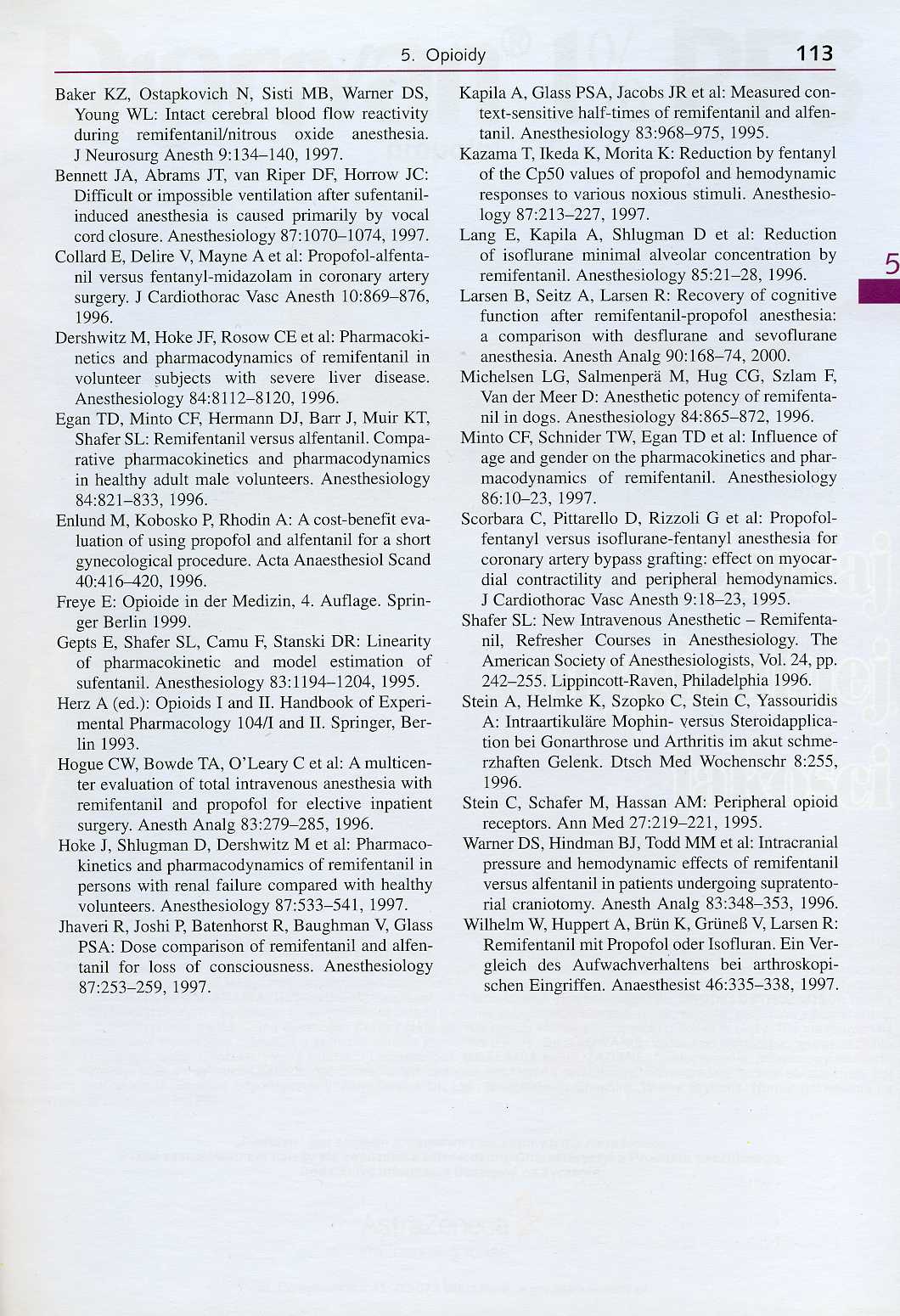larsen0113

5. Opioidy 113
Baker KZ, Ostapkovich N, Sisti MB, Warner DS, Young WL: Intact cerebral blood flow reactivity during remifentanil/nitrous oxide anesthesia. J Neurosurg Anesth 9:134— 140, I997.
Bennett JA, Abrams JT, van Riper DF, Horrow JC: Difficull or impossible ventilation after sufentanil-induced anesthesia is caused primarily by vocal cordclosure. Anesthesiology 87:1070-1074, 1997.
Collard E, Delire V, Mayne A et al: Propofol-alfenta-nil versus fentanyl-midazolam in coronary artery surgery'. J Cardiothorac Vasc Anesth 10:869-876, 1996.
Dershwitz M, Hoke JF, Rosow CE et al: Pharmacoki-netics and pharmacodynamics of remifentanil in volunteer subjects with severe liver disease. Anesthesiology 84:8112-8120, 1996.
Egan TD, Minto CF, Hermann DJ, Barr J, Muir KT, ShaferSL: Remifentanil versus alfentanil. Compa-rative pharmacokinetics and pharmacodynamics in healthy adult małe volunteers. Anesthesiology 84:821-833, 1996.
Enlund M, Kobosko P, Rhodin A: A cost-benefit eva-luation of using propofol and alfentanil for a short gynecological procedurę. Acta Anaesthesiol Scand 40:416-420, 1996.
Freye E: Opioide in der Medizin, 4. Auflage. Springer Berlin 1999.
Gepts E, Shafer SL, Camu F, Stanski DR: Linearity of pharmacokinetic and model estimation of sufentanil. Anesthesiology 83:1194-1204, 1995.
Herz A (ed.): Opioids I and II. Handbook of Experi-mental Pharmacology 104/1 and II. Springer, Berlin 1993.
Hogue CW, Bowde TA, CTLeary C et al: A multicen-ter evaluation of total intravenous anesthesia with remifentanil and propofol for elective inpatient surgery. Anesth Analg 83:279-285, 1996.
Hoke J, Shlugman D, Dershwitz M et al: Pharmacokinetics and pharmacodynamics of remifentanil in persons with renal failure compared with healthy volunteers. Anesthesiology 87:533-541, 1997.
Jhaveri R, Joshi P, Balenhorst R, Baughman V, Glass PSA: Dose comparison of remifentanil and alfentanil for loss of consciousness. Anesthesiology 87:253-259, 1997.
Kapila A, Glass PSA, Jacobs JR et al: Measured con-text-sensitive half-times of remifentanil and alfentanil. Anesthesiology 83:968-975, 1995.
Kazama T, Ikeda K, Morita K: Reduction by fentanyl of the Cp50 values of propofol and hemodynamic responses to various noxious stimuli. Anesthesiology 87:213-227, 1997.
Lang E, Kapila A, Shlugman D et al: Reduction of isoflurane minima! alveolar coneentration by remifentanil. Anesthesiology 85:21-28, 1996.
Larsen B, Seitz. A, Larsen R: Recovery of cognitive function after remifentanil-propofol anesthesia: a comparison with desflurane and sevoflurane anesthesia. Anesth Analg 90:168-74, 2000.
Michelsen LG, Salmenpera M. Hug CG, Szlam F. Van der Meer D: Anesthetic potency of remifentanil in dogs. Anesthesiology 84:865-872, 1996.
Minto CF, Schnider TW, Egan TD et al: Influence of age and gender on the pharmacokinetics and pharmacodynamics of remifentanil. Anesthesiology 86:10-23, 1997.
Scorbara C, Pittarello D, Rizzoli G et al: Propofol-fentanyl versus isoflurane-fentany! anesthesia for coronary artery bypass grafting: effect on myocar-dial contractility and peripheral hemodynamics. J Cardiothorac Vasc Anesth 9:18-23, 1995.
Shafer SL: New Intravenous Anesthetic - Remifentanil, Refresher Courses in Anesthesiology. The American Society of Anesthesiologists, Vol. 24, pp. 242-255. Lippincott-Raven, Philadelphia 1996.
Stein A, Helmke K, Szopko C, Stein C, Yassouridis A: Intraartikuliire Mophin- versus Steroidapplica-tion bei Gonarthrose und Arthritis im akut schme-rzhaften Gelenk. Dtsch Med Wochenschr 8:255, 1996.
Stein C, Schafer M. Hassan AM: Peripheral opioid receptors. Ann Med 27:219-221, 1995.
Warner DS, Hindman BJ, Todd MM et al: Intracranial pressure and hemodynamic effects of remifentanil versus alfentanil in patients undergoing supratento-rial craniotomy. Anesth Analg 83:348-353, 1996.
Wilhelm W. Huppert A. Briin K, GriineB V, Larsen R: Remifentanil mit Propofol oder Isofluran. Ein Ver-gleich des Aufwachverhaltens bei arthroskopi-schen Eingriffen. Anaesthesist 46:335-338, 1997.
Wyszukiwarka
Podobne podstrony:
larsen0093 5. Opioidy 93 miczną, selektywnością receptorową i rolą neuro-chemiczną. Endogenne opioid
larsen0095 5. Opioidy 954.1.1 Działanie przeciwbólowe Tłumiące i znoszące ból działanie opioidów jes
larsen0097 5. Opioidy 97 nic do wielkości główki od szpilki, które jednak pod wpływem silnej hipoksj
larsen0099 5. Opioidy 994.6 Skóra Kliniczne dawki morfiny rozszerzają naczynia skó
larsen0101 5. Opioidy 101 Tabela 5.2 Parametry fizykochemiczne i farmakokinetyczne opioidów do celów
larsen0103 5. Opioidy 103 - umiarkowana lub silna analgezja: 40-80 ng/ml, -
larsen0105 5. Opioidy 105 Pólokres ustalania równowagi między krwią a mózgiem wynosi dla remifentany
larsen0109 5. Opioidy 109Postępowanie praktyczne Początek infuzji ciągłej dobraną indywidualnie dawk
larsen0111 5. Opioidy 111 opioidów. Działa kompetycyjnie antagonistycznie wobec wszystkich receptoró
larsen0107 5. Opioidy 107Niewydolność wątroby i nerek Nawet ciężkie zaburzenia czynności wątroby nie
larsen0084 84 I Podstawy farmakologiczne i fizjologiczne pewną sennością. Skojarzenie benzodiazepin
larsen0092 92 I Podstawy farmakologiczne i fizjologiczne1 Wstęp Opioidy należą do związków najczęści
larsen0094 94 I Podstawy farmakologiczne i fizjologiczne Tabela 5.1 Receptory opioidowe, agoniści,
larsen0118 118 I Podstawy farmakologiczne i fizjologiczne Tabela 6.3 Zalecane dawki hipnotyków i
larsen0121 6. Znieczulenie całkowicie dożylne (TIVA) 121 i przed rozpoczęciem indukcji opioid w bolu
larsen0822 822 II Anestezjologia ogólna Tabela 30.4 Opioidy w leczeniu bólu pooperacyjnego u
larsen0843 31. Leczenie bólu pooperacyjnego 8434.3 Wybór opioidu W leczeniu bólu p
larsen0845 31. Leczenie bólu pooperacyjnego 845 Tabela 31.1 Opioidy w leczeniu bólu pooperacyjnego (
larsen0854 854 li Anestezjologia ogólna8.9.3 Wybór leku Poszczególne opioidy różni
więcej podobnych podstron